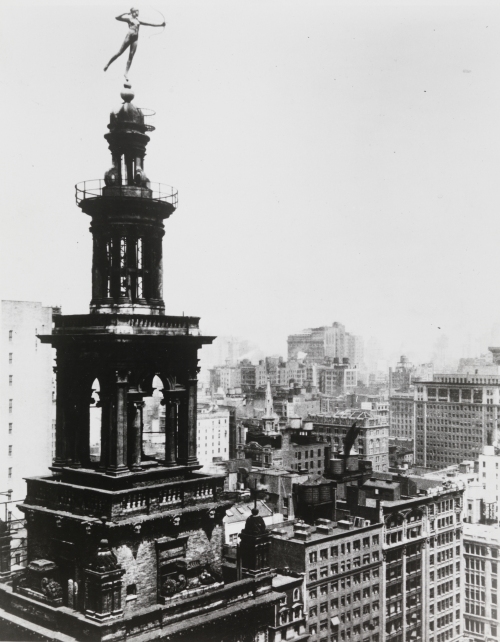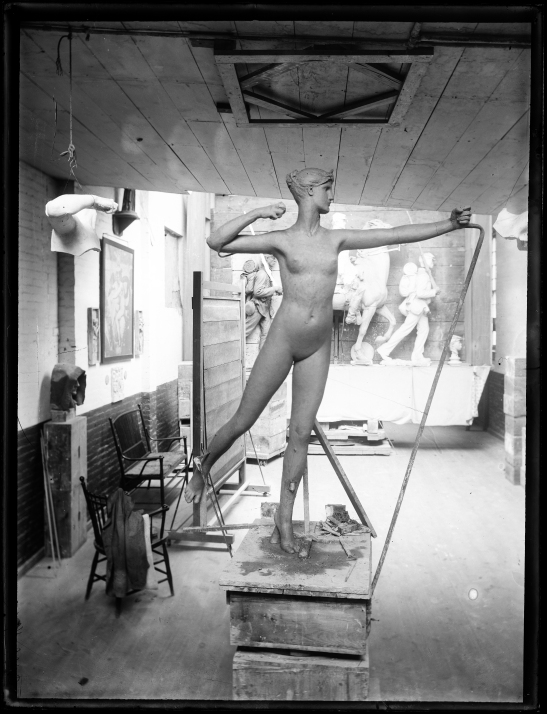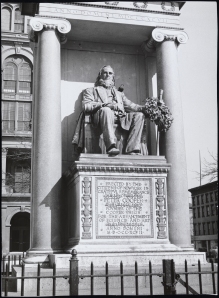MCNY Blog: New York Stories
Iconic photos of a changing city, and commentary on our Collections & Exhibitions from the crew at MCNY.org
Diana, by Augustus Saint-Gaudens
The gilded statue of Diana, Goddess of the Hunt, adorned the tower of Madison Square Garden and held watch over New York City for over three decades. She is arguably the most famous and recognizable work by sculptor Augustus Saint-Gaudens. This year the Philadelphia Museum of Art, the current home of Diana, has begun conservation to return her to her original gilded splendor.

Statue of Diana atop the tower of the Second Madison Square Garden. Ca. 1910. Museum of the City of New York. X2010.11.14116.
Madison Square Garden has been demolished and rebuilt several times since its first incarnation in 1875. Located at 32nd Street between 7th and 8th Avenues, our current Madison Square Garden is actually the fourth building and location. The most striking, and bearing absolutely no resemblance to its current form, was the second Madison Square Garden. Designed by renowned architect Stanford White, it opened in 1890 at 26th Street and Madison Avenue. This was the last Madison Square Garden to be located on Madison Square Park.
This beautiful Beaux-Arts structure towered over Madison Square Park. It was the second tallest building in New York City at the time. The New York Times called this Madison Square Garden, “one of the great institutions of the town, to be mentioned along with Central Park and the bridge of Brooklyn.” Perhaps the most impressive feature was its tower, which was modeled after the Cathedral of Seville. Atop this height stood perhaps the most ornate weather vane ever to grace New York City’s skyline, Saint-Gaudens’s statue of Diana. At 347 feet, she became the tallest point in New York City, taller than the Statue of Liberty’s torch by 42 feet. Diana was the first statue to be lit at night by electricity. Her lithe gilded form shone brightly enough in the sun during the day to be seen along the Hudson River and into New Jersey.

Detail of Madison Square Garden’s Tower with the sculpture of Diana and surrounding rooftops. Ca. 1915. Museum of the City of New York. X2010.11.2429.
Originally Diana was much larger, in fact too large. At 18 feet tall and 1,800 pounds, the first Diana was too heavy to spin in the wind as designed. In September 1892, this Diana was removed and placed atop the Agriculture Building of the World’s Fair in Chicago. The second Diana, also know as “Diana of the Tower,” was scaled down to 13 feet and fabricated in lighter hammered sheet copper. Billowing fabric flowed behind her as she spun in the wind. Her athletic form was a perfect addition to a venue that hosted athletic events as well as other types of entertainment. The Diana statues were Saint-Gaudens’s only nude figures and this nudity brought notoriety to the building in 1892. During the Gilded Age of New York City, when it was scandalous for a lady even to expose her ankles in public, Diana was quite shocking.
Diana’s likeness was a combination of two models. The body was based on the most famous model in New York City at the time, the beautiful Julia Baird. Swedish model Davida Clark served as the inspiration for her face. Saint-Gaudens used Davida’s likeness for many of his statues and eventually the pair became a couple. They had a son together, Louis Clark, in 1889.

McKim, Mead & White. Model of Diana sculpture for tower of Madison Square Garden. 1887- 1891. Museum of the City of New York. 90.44.1.712
Diana reigned over the pinnacle of Madison Square Garden during a few shocking events. The most notorious was the murder of Stanford White on June 25, 1906. Well known for his womanizing, White had long been conducting an affair with Evelyn Nesbit, the young and beautiful wife of millionaire Harry Kendall Thaw. By 1906 Thaw had had enough. He shot White point blank in the rooftop restaurant theater underneath Diana’s feet. Coincidentally, the song that the chorus girls were performing as Thaw shot White was “I Could Love a Million Girls,” the finale of the show Mam’zelle Champagne.
Saint-Gaudens called New York City his home for most of his life and had a lasting influence on the arts community at large. Though born in Ireland in 1848, his parents immigrated to New York City when he was an infant and Saint-Gaudens was raised here, attending Cooper Union and the National Academy of Design. Saint-Gaudens is globally recognized as one of the most influential sculptors of the 19th Century. His work is located in close to 500 public spaces around the country, but his most well known are in New York City. The Cooper Union, which admitted Saint-Gaudens at the age of 13, is home to his statue of Peter Cooper in Cooper Square. Cooper Union still gives out an award in his honor every year.
His other notable New York City statues are Civil War General William T. Sherman at the southeast corner of Central Park, Civil War Admiral David Farragut in Madison Square Park, and Robert Richard Randall in Sailor’s Snug Harbor, Staten Island.

George Miller, Jr. General Sherman statue. 59th Street- 5th Avenue. Designed by the famous sculptor Saint-Gaudens. Ca. 1903. Museum of the City of New York. X2010.12.104

Byron and Company. Sailors’ Snug Harbor, Staten Island. 1899. Museum of the City of New York. 93.1.1.14147
Unfortunately, Madison Square Garden II, even with its multitude of sporting matches and theatrical performances, was not a financial success. The property owners, the New York Life Insurance Company, demolished it to construct their headquarters, Cass Gilbert’s New York Life Building. Diana was taken down in 1925 at the onset of demolition.
After more than three decades of exposure to the elements, Diana’s gild had become muted and tarnished. She required an indoor home, and today she stands at the top of the Great Stair Hall at the Philadelphia Museum of Art (PMA). New York Life Insurance Company gifted Diana to the PMA where she has been protected from the elements and viewable at a much closer proximity. This year it was announced that Diana will finally undergo conservation and be returned to her original gilded luster. The conservation staff is currently applying 180 square feet of gold leaf to her cleaned surface. Visitors to the PMA can view this process over the next four months. More information on the process may be found here.






Great article and photos, but implies that Stanford White and Evelyn Nesbit were conducting their affair while she was married to Thaw. Their affair had been several years earlier when Nesbit was a teenager (White’s passion for young girls was notorious) but Thaw could not control his jealousy.
Pingback: Up on the roof, entertainment en plein air | mcnyblog